Read, Jane (McKechnie Section 6)
Recorded by Mills, Jane Read, one of the finest of oil painters of profiles on glass as well as a miniature painter, was the daughter of the profilist Mrs Isabella Beetham (see Section Three).
In 1773, the likely year of Jane's birth, Edward and Isabella Beetham were living as lodgers in London, either in Clerkenwell or in Holborn. Jane would have accompanied her parents during their various movements in the 1770s and early 1780s, and when her brother William was baptized in Westmoreland in 1778, no doubt she also was taken thither to see her grandparents. When the Beetham family settled at 27 Fleet Street in about May 1785, Jane was eleven or twelve years old. She soon showed that she had inherited her mother's artistic talent; by 1794 she was a sufficiently proficient artist to exhibit four examples of her work at the Royal Academy. She assisted in her mother's studio during the early 1790s. She certainly took lessons in painting from the Cornish painter John Opie (1761-1807), who was one of the well known visitors to 27 Fleet Street. As a young man, Opie had enjoyed the patronage of Lord Bateman; in the early 1780s he came to London and in 1787 was elected a Royal Academician. By this time he had married but, at some time during the mid-1790s, his wife, Mary, fell in love with a young man called John Edwards. By this time Opie was himself much in love with his pupil Jane and, when Mary eloped with Edwards, took the opportunity to sue her for divorce (1796), hoping to marry Jane, who was about twelve years younger than he was (see Ada Earland, John Opie and his Circle, London, 1911). In the event Jane rejected Opie, and married a lawyer, John Read, probably in 1797. (Some generations later, a member of the Beetham family did marry into the Opie family. Mrs Wilcox, a descendant of the Westmoreland branch of the Betham family, owned a china jug, on which was painted the inscription 'Nancy Opie, St. Agnes, 1811', as well as a silver cheese scoop engraved with Edward Beetham's initiais. Mrs Wilcox's maternal grandmother was born Eleanor Betham, and her mother-in-law was descended from the Opie family. Mrs Wilcox's sister owned Opie's silver watch, and it is believed that Nancy Opie was the painter's niece.)
There were two lawyers named John Read in practice in London at this date. One was a barrister whose chambers were at 16 Mitre Court and who was therefore a near neighbour of the Beethams; despite this fact, however, and the fact that Jane is traditionally supposed to have married a lawyer much older than herself, as this one was, it is now certain that she married another John Read, who was an 'attorney' (solicitor). He is listed in the records of the Law Society as having worked at the following addresses: Guildhall, 1799-1806; 72 Lamb's Conduit Street (the address on Jane Read's trade label), 1807-26; 22 Stamford Street, Blackfriars, 1827-47. It is because Jane ceased to send in exhibits to the Royal Academy from 27 Fleet Street after 1797 that it is likely that she married Read during that year. We know from Read's death certificate (No. 497, St Saviour's Church, Surrey) that he died on 25 January 1847, aged seventy-five. He was therefore born in 1772, and was not much older than Jane. His death was registered by Cordelia Angelina, their oniy daughter.
Jane's lengthy list of Royal Academy exhibits, given below, tells us that after marriage she not only exhibited as 'Mrs Jane Read' but also (once) as 'Miss J.Beetham' and (more often) as 'Miss J. Betham'. The list shows several addresses. Those from which the artist sent in work under the name 'Miss J. Betham' were 26 Maddox Street; 9 Foley Place, Portland Place; 4 New Cavendish Street, Portland Place; 49 Upper Marylebone Street, and 64 Upper Charlotte Street. We know from Graves (The British Institution) that 4 New Cavendish Street and 49 Upper Marylebone Street were also used at the same dates by her cousin Mary Matilda Betham, as was 64 Upper Charlotte Street in 1816 (Foskett records an exhibit by Miss M. Betham sent in from this address in that year). It seems likely that at all of these addresses there were studios which Jane Read shared with her cousin, and that (either by way of courtesy to her cousin or by arrangement with her) she adopted this form of her maiden name while they were together.
The exhibits sent in by the artist under her married name from 72 Lamb's Conduit Street need no explanation; it was at this address that she and her husband lived. Only the address 94 Wimpole Street, from which she sent in exhibits as 'Miss J Beetham' in 1806, remains unexplained. Either this was the address of a studio or the Reads may have been living there before they moved in the same year to 72 Lamb's Conduit Street, and as her parents were still living in Fleet Street during that year, she may have used her maiden name, which was better known in the world of art than was the name 'Read'.
The latest dated profiles by Jane Read which I have seen were painted in 1815, and she ceased sending in work to the Royal Academy after 1816. She may have discontinued painting partly because her husband had become not only a successful lawyer but also a rich owner of property. After the Reads had moved to 22 Stamford Street in 1827 they remained there until they died.
John Read made a will on 24 February 1836; this was proved on 27 July 1847 and reads as follows: 'I, John Read, formerly of Lamb's Conduit Street, now of Stamford Street, Gentleman, give all my PERSONAL ESTATE, (subject to the usual debts &c.) to my wife JANE READ for her use and benefit. All my REAL ESTATE to the use of such persons, and for such purposes as my daughter Cordelia Angelina Read shall from time to time by any deed[s] by her last will & testament and codicils in writing thereto appoint. In default and until such appointment shall not extend to the use of my said daughter, her heirs and assigns for ever.' It was further stated in this will that if Cordelia should die before Jane, the real estate was to pass to Jane. Jane and Cordelia were joint executrices. The will was proved at £18,000, but, as I have mentioned, Read had become a considerable property owner and when Cordelia died in 1871 her will was proved at the much higher figure of £120,000. Jane and her daughter continued to live in Stamford Street, their wealth accumulating, though they allowed their house to fall into disrepair. Dr Frederick Beetham (`Mrs Beetham, Silhouettist', an unpublished manuscript in the library of the Victoria and Albert Museum, London) tells of many contemporary newspaper reports which testify to their eccentric behaviour; the headlines include 'The Ghost of Stamford Street', Strange Scene in Blackfriars Road', and 'The Ruinous House in Stamford Street'. Jane and Cordelia were known as the 'old sisters' of Stamford Street.
The relevant census form of 1851 shows Cordelia (stated as being aged sixty) as the head of the household, and as a proprietor of houses, born in Middlesex. Jane's name, however, is not included; she may have been away from home at the time of the census, but, since she was by then about seventy-eight, this seems unlikely. If Cordelia really was sixty, she would have been born in c. 1791, when her mother, who did not marry until 1797, was only twelve. It seems more likely that the information on the census form (given by Mary Lacey, who was to register Jane Read's death; see below) was wrong.
Jane Read died on 16 January 1857. She is described on the death certificate as `widow of John Read, owner of houses'. Her age is given as seventy-eight, but it must in fact have been nearer eighty-four. It was not Cordelia, but Mary Lacey, a servant at 22 Stamford Street, who registered these details. (Cordelia may not have been sufficiently sound in mind to do this, and Mary Lacey, having no accurate source of information, probably guessed the ages.) Jane left no will, and letters of administration were granted to Cordelia, as her `natural daughter' and only child. Jane's estate totalled less than £3,000.
Cordelia died on 6 December 1871 at 43 Stamford Street. In due course, the Beetham family were to contest (unsuccessfully) the terms of her will, since she left none of the vast fortune mentioned above to any member of the family, but bequeathed all of it, including all her 'household Furniture, Pictures, Goods, Chattels, Trinkets, Jewellery', to the Consumption Hospital, Brompton, where, in the early 1880s, Dr Frederick Beetham saw a number of silhouettes painted on glass in a large case, and some old jewellery and snuffboxes. The silhouettes he presumes to be by Mrs Beetham and/or Jane Read.
I give below the list of exhibits sent in by Jane Read to the Royal Academy, as recorded by Graves (Royal Academy, Dictionary of Contributors): a longer list than that of any other artist recorded in this book.
As Miss J. Betham
From 26 Maddox Street
1804 723 Mr Manners
751 Countess of Dysart
752 Miss Manners
753 Dut Mess of St Albans
As Miss J. Beetham
From 27 Fleet Street
1794 37 Eloisa
53 Andromeda
196 Boy
223 Judith
1795 3 King Lear and Cordelia
56 A Lady reading a Letter
293 Portrait of a Sleeping Child
1796 60 Portrait of a Young Lady (Miss Harriet Beetham)
280 Portrait of a Gentleman (Mr. Beetham)
292 Portrait of a Lady
384 Portrait of a Lady and her Son (Mrs. Beetham)
1797 116 Portraits of Children
228 Portrait of a Lady
270 Portrait of a Lady
334 Portrait of a Lady
As Miss J. Betham
From 26 Maddox Street
1804 723 Mr. Manners
751 Countess of Dysart
752 Miss Manners
753 Dutchess of St. Albans
1805 339 Portraits of Miss Rouse Boughton, F.F. Baker Esq., Mr. Finucane
As Mrs. Jane Read
An honorary exhibitor [no address given for the following exhibit]
1805 530 An Old Lady taking Snuff
From 72 Lamb’s Conduit Street
1808 45 Portrait of a Lady
370 Portrait of a child with Butterflies
1809 4 The Novel Reader
1813 531 Miss C. A. Read
563 Portrait of an Artist
1814 355 Cordelia Angelina
As Miss J Beetham
From 94 Wimpole Street
1806 657 Sir C.R. Boughton (portrait miniature)
760 Framed portraits of Miss Chessyre, Rt. Hon. Lady Fauconberg, Miss E.
Betham, Lady Wilson, Mrs. Boughton
As Miss J. Betham
From 9 Foley Place, Portland Place
1807 791 Portraits of Mrs. C Thomson, Miss M. Graham, Mr. Saxon, Master F.
Thompson, the late Rt. Hon. Lady E. Gamon, Mr Dyer the poet,
Miss R. Boughton
846 Portrait of a Lady
From 4 New Cavendish Street, Portland Place
[In a later book (The British Insatitution) Graves lists Mary Matilda Betham as sending in exhibits 1808-11 from 14 Cavendish Place; he may have been correcting a wrongly noted address (4 New Cavendish Street) in his earlier book.]
1808 759 Gaiety (a miniature)
761 Portrait of a Lady (a miniature)
779 Portraits of Mr. De Vencille, Mr. Southey the poet, Mr. C Betham,
Mr. G. Betham
813 Portrait of Miss Armstrong
1810 578 A frame containing portraits of Rev. W. Betham, Miss Duncan, and a
self-portrait
From 49 Upper Marylebone Street
1811 585 Portraits of Rev. P. Stockdale and Miss B. Betham
1812 458 Rev. W. Betham
471 Mrs. Pymar
From 64 Upper Charlotte Street
1816 609 Portraits of Mrs. Colonel Gordon, Mrs. J. Betham, Mrs. R.G. Betham,
Miss A. Dove
As Miss J. Betham
From 26 Maddox Street
1804 723 Mr Manners
751 Countess of Dysart
752 Miss Manners
753 Dut Mess of St Albans
Although Graves states that some of these exhibits are portrait miniatures, it seems that the list also includes a number of easel portraits.
In 1805 Jane sent in to the Royal Academy a portrait of her cousin Matilda Betham, eldest daughter of Edward Beetham's brother Sir William Betham. Matilda was a self-taught miniaturist, and she also often exhibited at the Royal Academy before 1816. Long quotes from an unnamed source an account of her work which describes it as 'showing much sweetness and delicacy of finish, but from a lack of training, weakly drawn.' Born in 1776, she was younger than Jane; she died in 1852.
As one might expect, Jane Read's early profiles show her mother's influence to some extent. Two illustrated examples show this influence in the painting of clothing, although the faces are painted somewhat in the manner of Lea.
1556, 1557
One example is in the papier mâché frame, with pearwood surround, which was commonly used at Mrs Beetham's Fleet Street studio during the late 1790s.
1556
Both profiles are backed with the yellow wax which, again, was used at the studio during this period. (Jane Read, incidentally, did not back her profiles with plaster slabs, as did Lea, and her work and his could be differentiated for this reason alone.) It is possible that either or both of these profiles were painted w hile Jane was still work-ing at 27 Fleet Street.
Jane Read later developed a much more finished and individual style, as the other illustrated examples show. A miniaturist, she adapted the miniaturist's technique of moulding features to her profiles on glass. She now placed her sitters against landscape backgrounds (more finished than the simple trees depicted on her early profiles), showing the outlines of her subject's face by setting it against a dark patch of foliage. The illustrations of enlarged details at the end of this Section show that, on these later examples, the artist used two sizes of brush and also a needle (again, in two sizes) for highlighting. Hair is painted in thick, dark strokes over smaller, thinner strokes. Sitters' faces are painted on a fingerprinted base, but, in order to show bone structure, the artist has wiped out the fingerprinting in places. The features are finely moulded by hatching and added stippling. Clothing, on these later profiles, is shown by hatching over a fingerprinted base. To indicate the light colour of the frill on a shirt-frill, the artist would wipe away this fingerprinting.
1562
The later profiles are painted on convex glass and are backed with a composition containing some wax which is of more refined quality than the yellow wax used on the early work. Some examples are in papier mâché frames, with ovals of elaborately engraved ormulu or (more rarely) plain brass. One illustrated example is set in a locket.
1562
The earliest trade label used by Jane Read is Trade Label No. 6 of Mrs Beetham (q.v., Section Three), who used it jointly with her daughter at 27
Fleet Street. I have not seen this, and cannot suggest at what date the quality or quantity of Jane's work at the studio began to warrant the inclusion of her name on this trade label, which, rarely seen as it has been, cannot have been in use for long. Its use must have been discontinued after her marriage in 1797, when she seems to have ceased working at the Fleet Street studio.
Some of Jane Read's profiles, apparently dating from the late 1790s and early 1800s, have survived without labels. Others, dating from c. 1806 onwards, may originally have borne Jane Read's trade label (it is illustrated). This bears the address 72 Lamb's Conduit Street, where Jane Read and her husband moved in c. 1806, and it continued in use from this date at least until 1815. Since examples on white and on blue paper are known, there must have been at least two printings. The text reads as follows:
AQUA-TINTA PROFILE LIKENESSES
Likenesses painted on Ground Crystals
in a New & Elegant Style producing
the Effect of Aqua-tinta Engraving
on a beautiful Transparency.
& requiring only one Minute's Sitting
by Mrs. Read
Portrait and Historical Painter
72, Lamb's Conduit Street,
London.
No profiles are known which bear any of the other addresses given in the lists of Royal Academy exhibits quoted above.
After the above text was written Mr W. E. Fox-Smith acquired a pair of profiles of an unknown man and woman in matching papier mâché frames. On the profile of the man (which bears on the reverse Jane Read's trade label) the sitter's face is painted in plain sepia. On the profile of the woman (painted much in the style of the late work done at 27 Fleet Street) the sitter's face is painted in black.
Ills. 1555-1563, 1588, 1591
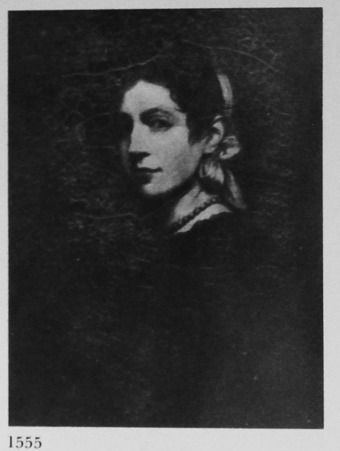
Jane Beetham, later Jane Read
Portrait in oils by John Opie, 1793-97. Opie also painted a portrait of one of Jane’s younger sisters (probably Harriet).
From Ernest Betham, ‘A House of Letters’ (London, Jarrolds, 1904)
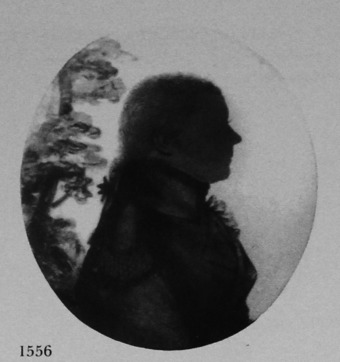
Unknown naval officer
Profile painted on glass, the sitter’s features rendered with light stippling
Late 1790s
3 ¾ x 3 ½ in./96 x 90mm.
Frame: papier mâché, with pearwood oval and plain verre églomisé border
M. A. H. Christie collection
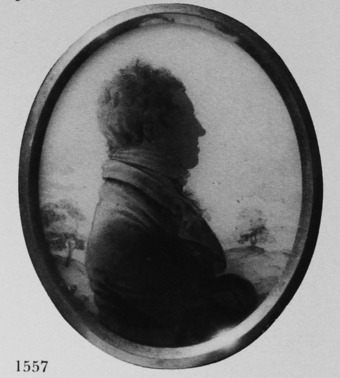
Unknown man
Profile painted on glass, the sitter’s features rendered with light stippling
Late 1790s-early 1800s
3 ¼ x 2 ¾ in./83 x 70mm.
Frame: papier mâché
J. A. Pollak collection
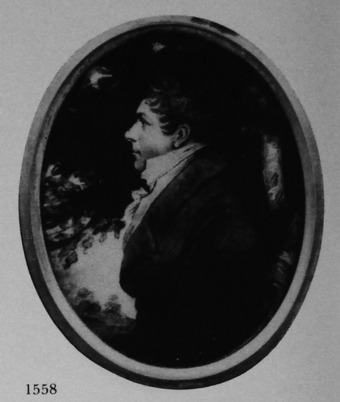
Unknown man
Profile painted on glass
c. 1807-10
3 ¼ x 2 ¾ in./83 x 70mm.
Trade Label
Frame: papier mâché, with oval brass surround
This profile, and the profiles shown in 1559-1563, are painted in the artist’s mature style, described in the text.
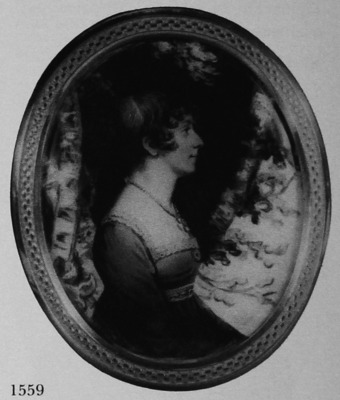
Unknown woman
Profile painted on glass
1810-12
3 ¼ x 2 ¾ in./83 x 70mm.
Frame: papier mâché, with ormolu matting oval
The increased sophistication of the treatment of the background in Jane Read’s later work is noticeable, in particular, in the rendering of the tree-trunks: a recurrent feature on her profiles.
J. A. Pollak collection
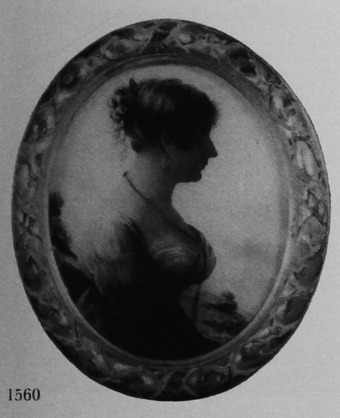
Unknown woman
Profile painted on glass
c. 1812
3 ¼ x 2 ¾ in./83 x 70mm.
Trade Label
Frame: papier mâché, with ormolu surround of leaf and ribbon design
This profile shows an interesting variation of the artist’s style of painting a background.
J. A. Pollak collection
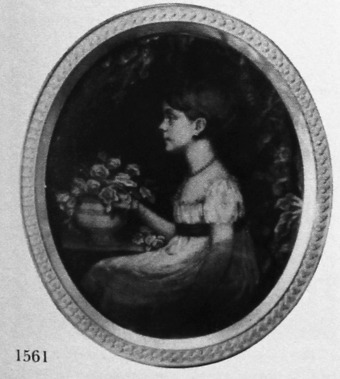
Miss Dixon
Profile painted on glass
1815
3 ¼ x 2 ¾ in./83 x 70mm.
Trade Label
This three-quarter length profile is inscribed on the reverse, ‘Miss Dixon, taken in 1815.’ Mayne owned a similar profile by Jane Read of Mrs Dixon, inscribed with this name and with the same date.
Author’s collection
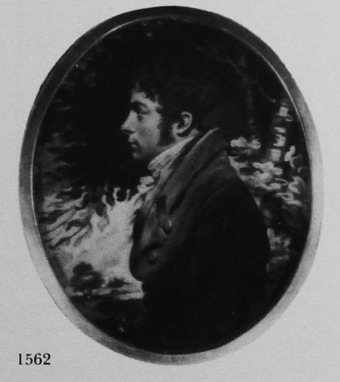
Locker of gilt/metal, containing a profile of the painter Sir David Wilkie painted on glass by Jane Read, probably c. 1812. Size of locket: 3 ¼ x 2 ¾ in./83 x 70mm.
Author’s collection
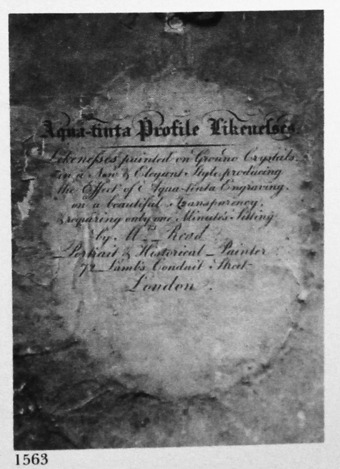
Trade label of Jane Read, from the profile illustrated in 1558.
Crown Copyright. Victoria and Albert Museum, No. P131-1931
Detail
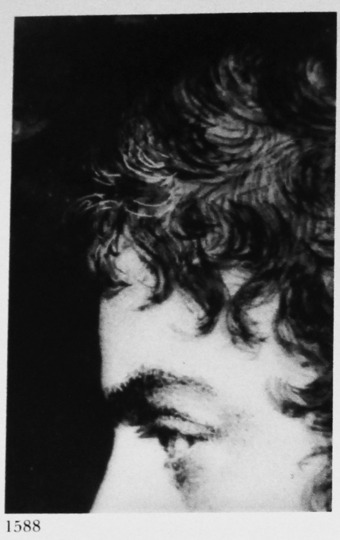
Hair and eye of a man. Detail from a profile by Jane Read. Note the highlighting, achieved with a slight touch of the needle. The hair is painted with brush-strokes over thinned pigment applied with finer brush-strokes. (1562)
Author’s collection
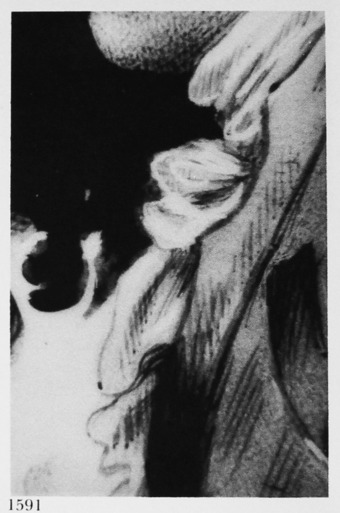
Shirt-frill and part of a frock. Detail from a profile of a man by Jane Read. The frock has been rendered with hatching over a fingerprinted base, part of which has been wiped away to show the lighter areas of the shirt-frill. (1562)
Author’s collection
